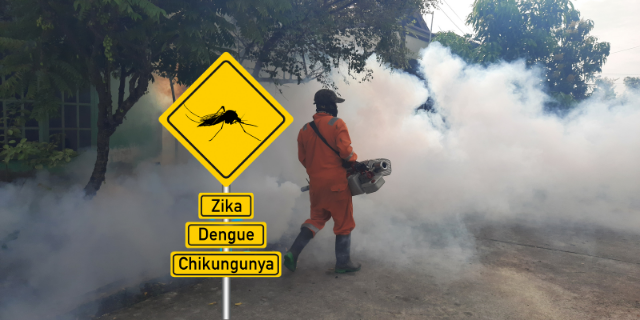24
Feb
Mosquito Resistance to Pesticides Continues to Grow

(Beyond Pesticides, February 24, 2022) Widespread, intensive pesticide use for mosquito control has allowed genetic mutations to persist among mosquito populations, causing subsequent resistance to future chemical exposure. According to a study published in Scientific Reports, two common species of female mosquitoes learned to evade pesticides following non-fatal exposure through smell. More concerning is the survival rate of these pre-exposed mosquitoes, as it is more than double that of unexposed mosquitoes. Insects, including mosquitoes, use various sensory and cognitive abilities like vision, smell, and hearing to navigate the ecosystem for survival and reproduction. Mosquitoes associate sensory stimuli like smell to a positive or negative experience, thus facilitating a response. Considering the two species of mosquitoes in this study are a vector for numerous diseases in humans, including dengue and Zika and West Nile viruses. Hence, this study highlights the significance of addressing pest resistance in pest management strategies, particularly to mitigate disease exposure and effects. The study notes, “[The] findings highlight the importance of mosquito cognition as determinants of pesticide resistance in mosquito populations targeted by chemical control.”
It is essential to understand insect behavior that propagates vector-borne disease transmission that exacerbates the widespread public health crisis. Scientists attribute memory and associative learning to behavioral changes occurring in responses to chemical exposure. The study focused on female Aedes aegypti and Culex quinquefasciastus mosquitoes that researchers exposed to a sublethal dose of five pesticide compounds. Using the World Health Organization (WHO) bioassays, researchers observe associative learning by exposing mosquitoes to sublethal doses of deltamethrin (pyrethroid), permethrin (pyrethroid), lambda-cyhalothrin (pyrethroid), propoxur (carbamate), and malathion (organophosphate). These chemicals represent the pesticides primarily used for vector control. Researchers then exposed female mosquitoes to the same chemical in the assay.
The result demonstrates that female mosquitoes previously exposed to a chemical avoid the same chemical when associated with adverse survival odds, seeking out blood to ensure survival. Thus, following a single exposure, mosquitoes can associate the smell of pesticides with their harmful effect to avoid contact with the said chemical. Female mosquitoes prefer to rest in a pesticide-free area rather than one prone to pesticide use.
This study resembles an all too familiar phenomenon of resistance among pest populations. Scientists note resistance is an entirely normal, adaptive phenomenon: organisms evolve, “exploiting” beneficial genetic mutations that give them a survival advantage. However, resistance is growing in all sectors of pest control, including critically needed agriculture and medicine. For nearly a century, the human response to resistance is the development of a compound that kills the resistant organism (whether pest or weed or bacterium or fungus), which works for a while. However, the dependence on chemical solutions is increasingly failing. Whether it is antibiotics for bacterial infections, herbicides for weeds/pests, or insecticides to mitigate vector-borne diseases, organisms are becoming resistant to usually toxic compounds. Once an organism inevitably becomes resistant to a particular chemical control strategy, people — the chemical industry, researchers, applicators, farmers, public health workers, clinicians, et al. — will have typically moved on to the subsequent chemical “solution.” Pesticide Action Network North America (PANNA) notes, “The World Health Organization underscored the problem in their 2012 guidance on policymaking for Integrated Vector Management (IVM): ‘Resistance to insecticides is an increasing problem in vector control because of the reliance on chemical control and expanding operations…Furthermore, the chemical insecticides used can have adverse effects on health and the environment.’”
Beyond Pesticides has written extensively on the issue of resistance, particularly the relationship to the use of agricultural and other land management pesticides, with the central message: resistance is a symptom of the ineffectiveness of chemical-intensive agriculture and leads to increased use of more and more toxic pesticides. In addition, resistance in one of the “sectors” mentioned above can “crossover” to become problematic in another. Growing pesticide resistance often leads to an increase in chemical inputs to control pests. Exposure to permethrin already has implications for human health, including cancer, endocrine (hormone) disruption, reproductive dysfunction, neurotoxicity, and kidney/liver damage. Mosquito resistance can augment the use of chemical control methods, including the addition of toxic synergists like piperonyl butoxide (PBO), known to cause and exacerbate adverse health effects from exposure. Therefore, researchers need to understand the mechanisms prompting pesticide resistance among mosquito populations to safeguard human health from disease.
In the context of deadly pesticide use in developing countries, Jay Feldman, executive director of Beyond Pesticides, has noted, “We should be advocating for a just world where we no longer treat poverty and development with poisonous band-aids but join together to address the root causes of insect-borne disease because the chemical-dependent alternatives are ultimately deadly for everyone.” He also said, “We should focus on the deplorable living conditions and inequitable distribution of wealth and resources worldwide that give rise to squalor, inhumane living conditions, and the poor state of development that, together, breed insect-borne diseases like malaria.”
Even if dengue is not a local concern, there remains general concern surrounding the diseases mosquitoes can transmit, including the West Nile and Zika virus. Beyond Pesticides provides valuable information on mosquito management and insect-borne diseases on the Mosquito Management and Insect-Borne Diseases section devoted to these issues. Furthermore, keep up on pesticide-related science and news, including mosquitoes and pesticide resistance on Beyond Pesticides’ Daily News blog.
All unattributed positions and opinions in this piece are those of Beyond Pesticides.
Source: ABC News, Scientific Reports










